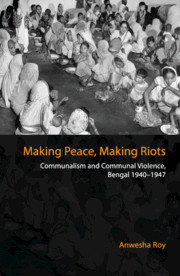Book contents
- Frontmatter
- Frontmatter
- Contents
- Maps and Figures
- Acknowledgements
- Abbreviations
- Glossary
- Introduction
- 1 The Dacca Riot, 1941
- 2 Famine 1943 – Towards a Hardening of Community Identities
- 3 From Community to Communal: The Bengal Secondary Education Bill and the Idea of Pakistan
- 4 The Great Calcutta Killing, August 1946
- 5 Noakhali Riots, October 1946
- 6 A Test of Faith: Gandhi in Noakhali and Calcutta 1946–47
- Concluding Remarks
- Appendix 1
- Appendix 2
- Appendix 3
- Appendix 4
- Bibliography
- Index
Concluding Remarks
Published online by Cambridge University Press: 23 October 2018
- Frontmatter
- Frontmatter
- Contents
- Maps and Figures
- Acknowledgements
- Abbreviations
- Glossary
- Introduction
- 1 The Dacca Riot, 1941
- 2 Famine 1943 – Towards a Hardening of Community Identities
- 3 From Community to Communal: The Bengal Secondary Education Bill and the Idea of Pakistan
- 4 The Great Calcutta Killing, August 1946
- 5 Noakhali Riots, October 1946
- 6 A Test of Faith: Gandhi in Noakhali and Calcutta 1946–47
- Concluding Remarks
- Appendix 1
- Appendix 2
- Appendix 3
- Appendix 4
- Bibliography
- Index
Summary
It is important that for a study of communalism, the focus should be on how, at given historical conjunctures, different subjectivities and the dynamics of identity formation relate to one another. The given-nes or the fixity of the nature of communalism is what needs to be contested. In violence of such magnitude, as were witnessed in the Great Calcutta Killing and the Noakhali riots, it is difficult to pinpoint a definite causal connection. An intermix of multiple factors operated at specific historical conjunctures to make up a potent combination that took communalism to its peak and made riots of such magnitude possible.
It was interesting to observe how the Muslim peasants of East Bengal came out in support of the Pakistan movement generated by a party which had to acquire a mass base to be successful. The idea of Pakistan embodied the peasant needs and acquired a millenarian appeal by 1946. The fluid process of identity formation, where multiple jostling identities coexisted in the consciousness of the peasant community, relates to the Gramscian concept of ‘contradictory common-sense’ of subalterns. Simply put, it means that the structure of ordinary, quotidian ‘common sense’ is contradictory in character: protests yesterday and subordination today, social satirization of upper-class norms, even when subjected to their control, millenarian hopes entwined with fatalistic submission and so on. A crucial element of this complex subaltern consciousness is its originality, which is a part of the creative thought process of the subaltern groups. Even when rationalizations of the caste/class system are accepted by the ‘lower’ castes/lower classes, there is discontent and resentment about their subordination. Contradictions are thus embedded in this structure of thought.
We have seen how the self-conceptualization of the peasantry as a religious group (Muslims) and that as a class co-existed and constantly interacted with each other. Even when sectarianism replaced class consciousness as the context of mass violence, some of the distinctive traces of class still remained, which was why indeed there was often an overlap between anti-landlord jacqueries and Hindu–Muslim riots. Even while supporting the millenarian idea of Pakistan, with which the peasants hoped to overthrow the Hindu zamindari opposition, they accepted the social hierarchies that Pakistan might bring to them.
- Type
- Chapter
- Information
- Making Peace, Making RiotsCommunalism and Communal Violence, Bengal 1940–1947, pp. 247 - 250Publisher: Cambridge University PressPrint publication year: 2018



